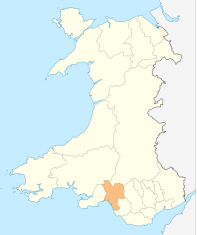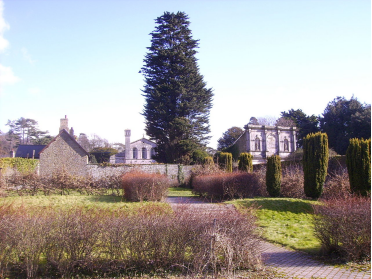Neath Port Talbot, Wales, UK 作者: 来源: 发布时间:2021-09-17
I. Population and Area
Continent: Europe
Country: The U.K
State/Province: Wales
City/Town: Neath Port Talbot
Total Area: 171 (sq mi)
Population in 2017: 142.91 (thousand)

II. Natural Geography (environment and resources)
Geography
The local authority area stretches from the coast to the border of the Brecon Beacons National Park. The majority of the land is upland or semi-upland and 43% is covered by forestry with major conifer plantations in upland areas. Most of the lower-lying flat land is near the coast around Port Talbot. An extensive dune system stretches along much of the coast, broken by river mouths and areas of development. The upland areas are cut by five valleys: Vale of Neath, Dulais Valley, Afan Valley, Swansea Valley, Upper Amman Valley.

Modern settlement patterns reflect the industrial history of the area, with urban development along the flatter areas of the valleys and some parts of the coast. Neath with a population of 47,020 is the largest town, followed by Port Talbot (35,633), Briton Ferry (7,186), Pontardawe (5,035), and Glynneath (4,368). The majority of the population live in the coastal plain around Port Talbot and the land around the River Neath in the vicinity of Neath. Much of the larger towns in the borough lie within the Swansea Urban Area.
Harbour
Harbour Way is the largest transport project supported by ERDF Convergence programme in Wales and is a major boost for the regeneration in Neath Port Talbot. The road was officially opened on 08th October 2013 by the First Minister, Rt. Hon Carwyn Jones. It provides a 4.8km link to the M4 at junction 38 into Port Talbot and the docks.
This strategic road opens up development opportunities along the waterfront area, in particular at Harbourside, the docks area, and Port Talbot town centre. It will benefit local communities, visitors and businesses alike and will support the Council’s efforts in attracting new investment and employment opportunities.
Port Talbot Parkway
The multi million pound Port Talbot railway station redevelopment is underway. The station was the subject of extensive renewal works in the 1960s and was designated as a ‘Parkway’ in the 1980’s. Around ½ million passengers use the station every year and the proposed redevelopment has been welcomed.
The development includes a new enclosed footbridge with lifts providing step free access to the platform. There will be a new ticket office and waiting areas was well as a café and retail area and improvements to customer information. It also includes a 200 space car park with a park and ride for commuters along with improved facilities for cyclists, bus passengers and taxis.
Reference Website:
https://www.npt.gov.uk/2673
III. Economy
Average earnings and employment vary considerably across Wales. They are both generally higher in east Wales, especially in urban areas, but lower in south west Wales an
Regions (NUTS3) | GDP € (2013) | GDP per capita € (2013) | GDP € (2016) | GDP per capita € (2016) |
Gwent Valleys | € 5.962 bn | €17,500 | € 6.923 bn | €20,200 |
Bridgend & Neath Port Talbot | € 6.016 bn | €21,500 | € 7.240 bn | €25,400 |
Swansea | € 5.532 bn | €23,100 | € 6.332 bn | €25,800 |
Monmouthshire & Newport | € 6.322 bn | €26,500 | € 7.260 bn | €30,000 |
Cardiff & Vale of Glamorgan | € 14.361 bn | €30,000 | € 16.590 bn | €33,900 |
Flintshire & Wrexham | € 8.346 bn | €28,800 | € 9.374 bn | €32,200 |
Powys | € 2.869 bn | €21,600 | € 3.134 bn | €23,700 |
TOTAL | € 71.396 bn | €23,200 | €81.683 bn | €26,200 |
the Valleys, although earnings in Bridgend and Neath Port Talbot, which are still centres of skilled manufacturing employment, are relatively high. In north and north west Wales, earnings are low but the employment rates are above the Welsh average.
Many parts of Wales suffered from a continuous decline in heavy industry over the 20th century, culminating in the virtual disappearance of coal-mining in the 1980s. The demise of 'smokestack' industries left a legacy of high unemployment, and although unemployment has declined in recent years, unemployment in West Wales and the Valleys still tends to be higher than the Welsh average and economic inactivity (a form of hidden unemployment) continues to be a major problem in these areas. Merthyr Tydfil and Neath Port Talbot have some of the largest proportions of people in the UK not working due to long-term illness or disability, though some believe that in reality many people classified as "unable to work" through sickness are low-skilled workers encouraged to exit the labour market by the benefits system as well as declining demand for their skills.
IV. Industrial Characterisitics
Major industries:
In 1991 Neath & Port Talbot was a distinct Travel to Work Area (albeit with different boundaries to the current county borough), but the 2001-based revision has merged the locality into a wider Swansea Bay Travel to Work Area.
In June 2008, the economic activity and employment rates in Neath Port Talbot were below the Welsh average. However, earnings for full-time workers were higher than either the Welsh or British average.
Manufacturing accounts for over 22% of jobs in the county borough compared to under than 14% in Wales as a whole; just under 70% of local jobs are in services compared to a Welsh average of nearly 80%. Tata is the largest employer with approximately 3,000 staff (although in 1979 its predecessor employed 12,600); other large employers include General Electric, Hi-Lex Cable Systems Ltd (closing in 2021 ), TRW Steering Systems recently closed, Envases (UK) Ltd, Crown Food UK & Ireland, Toyoda Koki, Sofidel, Cornelius Electronics, Excel Electronics Assemblies, and Tedeco.
Port Talbot is also the site for Neath Port Talbot Hospital which is situated on Baglan Way, Port Talbot.
Major projects and related introductions:
Regional go ahead for major £58.7 million Neath Port Talbot City Deal projects
An innovative portfolio of major Neath Port Talbot projects aimed at helping tackle climate change while safeguarding the future of the steel industry has been given a regional stamp of approval. Following the thumbs-up at a meeting of the Swansea Bay City Deal’s Joint Committee, the business case for the £58.7 million Supporting Innovation and Low Carbon Growth programme will now be submitted to the UK Government and Welsh Government for final sign-off.
With a targeted focus on the Port Talbot Harbourside area, the programme is projected to be worth £6.2 million a year to the local economy once all projects are operational. Over 1,300 jobs will be created or safeguarded, with at least 30% of these to be new.
Led by Neath Port Talbot Council, the Supporting Innovation and Low Carbon Growth programme is made up of four inter-linked elements:
An energy positive Swansea Bay Technology Centre building on Baglan Energy Park providing flexible office space for start-up companies and indigenous businesses, with a focus on the innovation, ICT and R&D sectors. The excess energy from solar and other renewable technologies will be converted into hydrogen at the nearby Hydrogen Centre to be used to fuel hydrogen vehicles.
A National Steel Innovation Centre that will support the steel and metals industry in Port Talbot and Wales, while reducing its carbon footprint.
Decarbonisation projects including an electrical vehicle charging network, as well as air quality modelling and real-time monitoring to enable better informed air quality decisions in future.
An Industrial Futures project to address the gap between demand and supply for businesses and available land in the Port Talbot Waterfront Enterprise Zone, with a hybrid building providing production units as well as office space to support start-ups and indigenous businesses in the innovation and manufacturing sectors. Land remediation is also planned, along with flood defence work, the construction of access roads and the upgrading of highways. A Property Development Fund will be made available to support private sector building schemes in the Enterprise Zone.
Reference Website:
https://www.npt.gov.uk/1410?pr_id=6392
V. Attractions
1. Afan Forest Park:

As the A4107 meanders through the steep sided valley it is easy to understand why this valley has been developed as a premier Mountain Bike riding venue in the United Kingdom. The Forest Park also has nine waymarked walking trails, ranging from a 30-minute amble to a 3-4 hour ramble. There are also miles of public rights of way to make up your own walks. As well as mountain biking, there is also a network of 25 miles (40 km) of disused railway lines which can be used for walking and cycling. These are called the Family Routes, or the Low Level Cycleway. These also form a link between the mountain bike trails.
The Forest Park Centre has camping facilities, with campsites with a shower block and toilet block which can also be used by other visitors. In addition to these basic facilities, the Centre also offers a cafe, small local museum on mining, bike shop and a gift shop.
2. Margam Country Park:

Margam Park owes its location and beginnings to the monastery, which was acquired by Sir Rice Mansel in 1540 after the Dissolution of the Monasteries in 1537. A Tudor mansion was later built on the site of the former monastic ranges by Sir Rice Mansel as a county residence. In 1661, the first mention of a garden is referenced, including walled areas and by 1727 the estate's gardener drew up a catalogue of the plants at the gardens. 1793 saw the completion of the Orangery, the masterpiece of eighteenth century architect Anthony Keck, and by the late 18th century the gardens were fenced off from the park to keep out the deer, and a main gate was erected. An 1814 estate map shows that a working park had been realised, with a 'Great', 'Little' and 'Upper' Parks, and by 1830 the construction of a new manor house, to become Margam Castle, had begun. Before the end of the decade, plans show the inclusion of several new buildings and features, including the Temple of the Four Seasons, the stone facade and the gardener's cottage.
The Margam Estate was acquired by Glamorgan County Council in July 1973, and the next year, after a Local Government re-organisation, the Park fell under the ownership of West Glamorgan County Council. The park was opened to the public in 1977.
in 1985 a sculpture park was established by the Welsh Sculpture Trust which exhibited work by internationally famous sculptors including Henry Moore, Barbara Hepworth and Elizabeth Frink. The sculpture park has since closed.
3. Aberdulais Falls:

The River Dulais rises on Mynydd y Drum in the western Brecon Beacons. It flows down the Dulais Valley, through the villages of Seven Sisters and Crynant, before reaching its confluence with the River Neath after about 7 mi (11 km). Here it flows over a ridge of Pennant sandstone, entering a gorge that was carved by meltwater from a glacier 20,000 years ago. Originally the falls were nearer the sea, but the water has eroded the rock and cut its way back to its present location. The River Dulais is prone to flash floods when heavy rain falls in its catchment area.
VI. History
Neath Port Talbot is full of fascinating cultural and environmental history and the Working with Nature sites are no different. As a historical researcher, you will be responsible for collating historical data for one of our sites and their surrounding area.
You will paint a picture of the changes to the site and the historical importance for nature, industry and settlements. Combining interviewing local residents with site visits and historical archives and books, you will help to discover the history of the site, providing important information that we can use on interpretation panels on site and as an online resource.
We will give you free reign to collate the information and you will benefit knowing that you are contributing to the protection of your sites historical importance and information and sharing the knowledge with the wider community and visitors to the site.
This role would suit someone with an interest in history and a desire to contribute to the wider understanding of the history behind our sites.
Reference Website:
https://www.npt.gov.uk/18073
VII. Culture
The local Neath Port Talbot Council is the education authority in the area which operates primary schools and secondary schools within the county. The local education authority operates 6 infant schools, 6 junior schools, 56 primary schools, 11 secondary schools and 3 special schools.
Further Education in Neath Port Talbot is provided by a range of institutions. St. Joseph’s Catholic School & Sixth Form Centre in Port Talbot and Ysgol Gyfun Ystalyfera have traditional sixth form settings. NPTC Group operates from several sites within the county borough. The largest sites are located in Neath, Port Talbot and Pontardawe.
The first dedicated higher education site in Neath Port Talbot opened in 2015 when Swansea University opened its science and innovation campus in Crymlyn Burrows.
The University of South Wales has a campus located at Baglan Energy Park in Port Talbot. The Baglan campus houses a Renewable Hydrogen Research and Development Centre.
A separate daily edition of the South Wales Evening Post is published for the Neath Port Talbot area. The paper's publisher, Reach plc, also produces a free weekly paper, the Neath Port Talbot Courier, which is inserted in Thursday's edition of the South Wales Evening Post. The local council publishes a quarterly, Community Spirit, produced and funded in conjunction with seven other public sector partners.
Community radio station is XS broadcasts to both Neath (97.4) and Port Talbot (107.9). Nation Radio briefly broadcast to the wider South Wales region from studios in Neath, but is now based in Cardiff. The county borough is within the local commercial radio licence areas for the CHR-formatted station 96.4 The Wave, its Soft Adult Contemporary sister station Greatest Hits Radio South Wales and the Adult Contemporary-orientated Swansea Bay Radio.
Reference Website:
https://npttheatres.co.uk/
VIII. Other information
On 1 April 1996, Neath Port Talbot was created from the former districts of Neath, Port Talbot and part of Lliw Valley. The name change happened on the following day. At the time of the reorganisation, many local people expected that Neath and Port Talbot districts would become separate unitary authorities, and there were protests when the new authority was announced.
Local Government
The whole of the Neath Port Talbot area was once part of the county of West Glamorgan, which in turn was part of the historic county of Glamorgan. Since local government re-organisation in 1996, Neath Port Talbot is governed by Neath Port Talbot County Borough Council.
Neath Port Talbot is a staunch Labour stronghold, who have been in power since the authority's formation in 1996.
Welsh politics
The unitary authority contains two whole constituencies which are:
·Aberavon, current MS is David Rees, Labour since 2011
·Neath, current MS is Jeremy Miles, Labour since 2016
United Kingdom politics
·Aberavon, current MP is Stephen Kinnock, Labour since 2015
·Neath, current MP is Christina Rees, Labour since 2015
IX. Contact information
Mayor/Officer: Scott Jones
Tel: 01639 763296
Mail: cllr.s.jones@npt.gov.uk
Reference Website:
https://democracy.npt.gov.uk/mgUserInfo.aspx?UID=57
